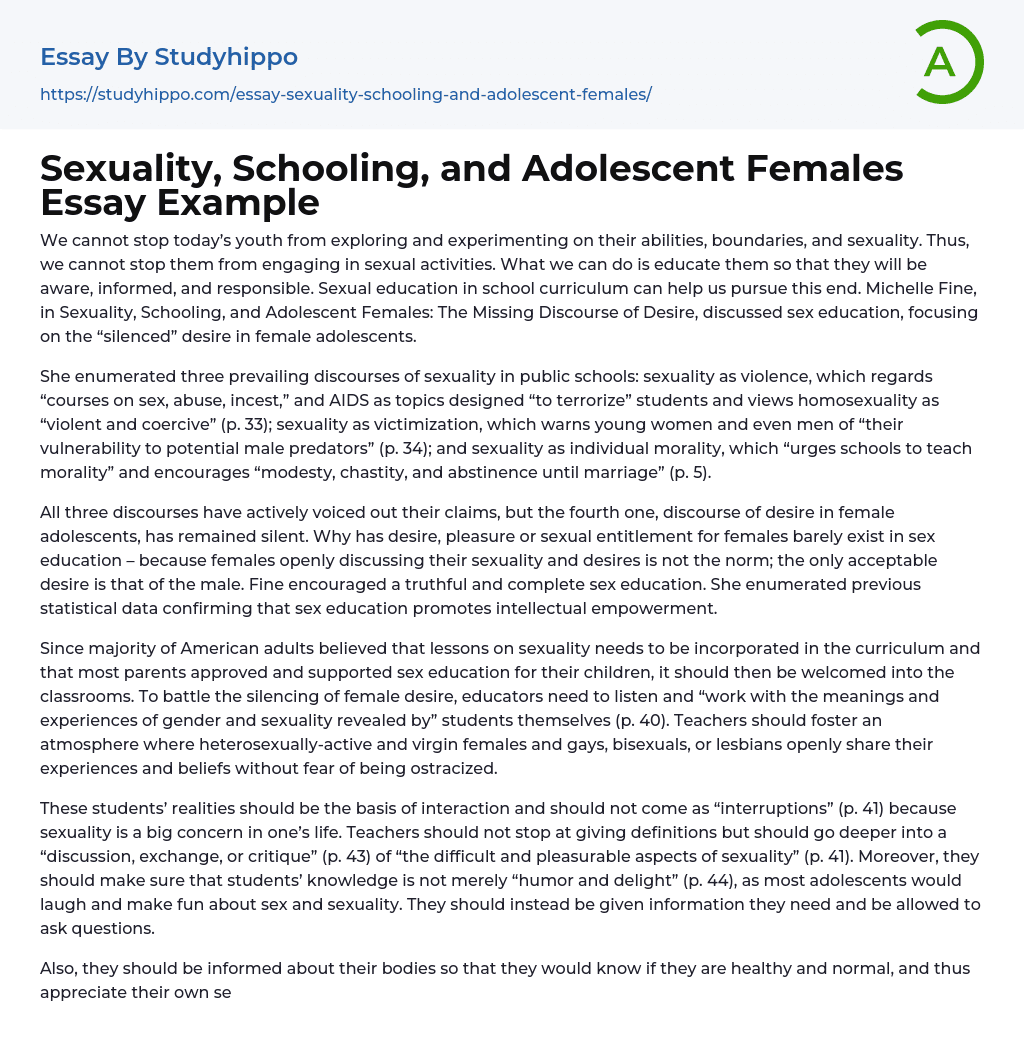

Sexuality, Schooling, and Adolescent Females Essay Example
We cannot stop today’s youth from exploring and experimenting on their abilities, boundaries, and sexuality. Thus, we cannot stop them from engaging in sexual activities. What we can do is educate them so that they will be aware, informed, and responsible. Sexual education in school curriculum can help us pursue this end. Michelle Fine, in Sexuality, Schooling, and Adolescent Females: The Missing Discourse of Desire, discussed sex education, focusing on the “silenced” desire in female adolescents.
She enumerated three prevailing discourses of sexuality in public schools: sexuality as violence, which regards “courses on sex, abuse, incest,” and AIDS as topics designed “to terrorize” students and views homosexuality as “violent and coercive” (p. 33); sexuality as victimization, which warns young women and even men of “their vulnerability to potential male predators” (p. 34); and sexuality a
...s individual morality, which “urges schools to teach morality” and encourages “modesty, chastity, and abstinence until marriage” (p. 5).
All three discourses have actively voiced out their claims, but the fourth one, discourse of desire in female adolescents, has remained silent. Why has desire, pleasure or sexual entitlement for females barely exist in sex education – because females openly discussing their sexuality and desires is not the norm; the only acceptable desire is that of the male. Fine encouraged a truthful and complete sex education. She enumerated previous statistical data confirming that sex education promotes intellectual empowerment.
Since majority of American adults believed that lessons on sexuality needs to be incorporated in the curriculum and that most parents approved and supported sex education for their children, it should then be welcomed into the classrooms. To battle
the silencing of female desire, educators need to listen and “work with the meanings and experiences of gender and sexuality revealed by” students themselves (p. 40). Teachers should foster an atmosphere where heterosexually-active and virgin females and gays, bisexuals, or lesbians openly share their experiences and beliefs without fear of being ostracized.
These students’ realities should be the basis of interaction and should not come as “interruptions” (p. 41) because sexuality is a big concern in one’s life. Teachers should not stop at giving definitions but should go deeper into a “discussion, exchange, or critique” (p. 43) of “the difficult and pleasurable aspects of sexuality” (p. 41). Moreover, they should make sure that students’ knowledge is not merely “humor and delight” (p. 44), as most adolescents would laugh and make fun about sex and sexuality. They should instead be given information they need and be allowed to ask questions.
Also, they should be informed about their bodies so that they would know if they are healthy and normal, and thus appreciate their own selves. In addition, educators should encourage dialogue between parents and children. Students should realize that school is not the only place where they could feel safe to discuss sex and sexuality (p. 40). If there is a safer arena for discourse, it should be in their homes. In this way, not only does sex education help students know their sexuality but also help preserve family and values. With all these, educators have a big responsibility on their shoulders.
Empowering sex education outside the classroom could be impossible since oppositions from outside thrive. Therefore, much intervention is expected to come
from educators in classrooms. To assist them in their task, Fine suggested that school-based health clinics (SBCHs) be allowed. Here, adolescents get the health counseling, examinations, and expert opinion (p. 51) that classrooms cannot give. Since majority of adults believed these clinics provide birth control information and contraceptives (p. 52), then schools should be encouraged to welcome SBHCs’ services.
We now live in a progressive world; we cannot be too strict and conservative about sex and sexuality, but can only be open to discourses involving these. We should encourage sex education for our children because contrary to what some believe, “sex education does not instigate an earlier onset or increase” in students’ sexual activity, but rather postpones it (cited in Fine, p. 50). We cannot stop the youth from exploring and experimenting but we can offer them real life options and empowerment, especially to the silenced female adolescents.
- Sexual Intercourse essays
- Adolescence essays
- Childhood essays
- Growth Mindset essays
- Individual essays
- Infant essays
- Is Google Making Us Stupid essays
- Caste System essays
- Citizenship essays
- Civil Society essays
- Community essays
- Culture essays
- Deviance essays
- Discourse Community essays
- Female essays
- Filipino People essays
- Igbo People essays
- Indigenous Australians essays
- Indigenous Peoples essays
- Men essays
- Middle Class essays
- Minority Group essays
- Modern Society essays
- Popularity essays
- Social Control essays
- Social Institution essays
- Social Justice essays
- Social Norms essays
- Social Responsibility essays
- Socialization essays
- The nation essays
- Adult essays
- Aggression essays
- Altruism essays
- Archetype essays
- Behavior essays
- Certainty essays
- Conformity essays
- Deception essays
- Human Behavior essays
- Human Sexuality essays
- Maturity essays
- Morality essays
- Obedience essays
- Procrastination essays
- Reinforcement essays
- Role Model essays
- Coaching essays
- Critical Thinking essays
- homework essays



